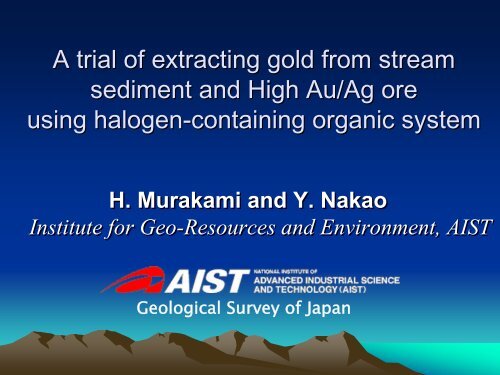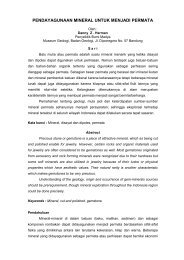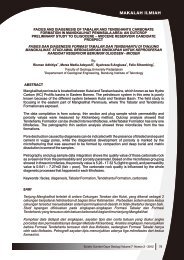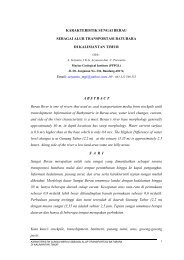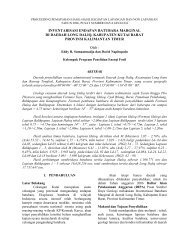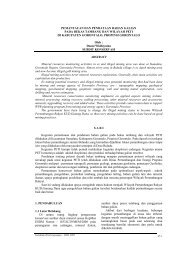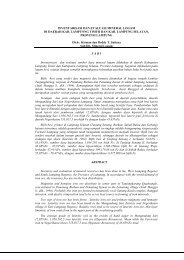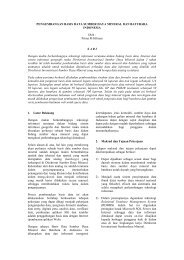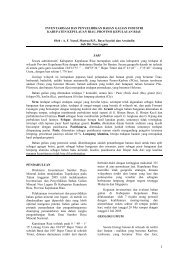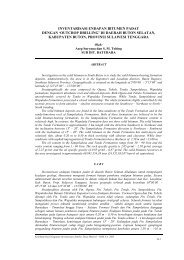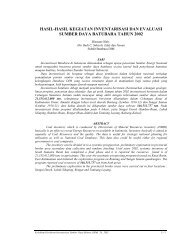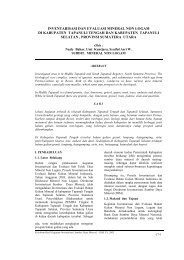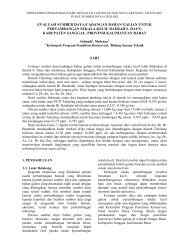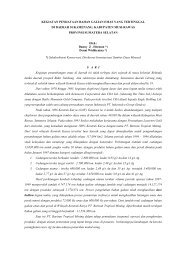A trial of extracting gold from stream sediment and High Au/Ag ore ...
A trial of extracting gold from stream sediment and High Au/Ag ore ...
A trial of extracting gold from stream sediment and High Au/Ag ore ...
Create successful ePaper yourself
Turn your PDF publications into a flip-book with our unique Google optimized e-Paper software.
A <strong>trial</strong> <strong>of</strong> <strong>extracting</strong> <strong>gold</strong> <strong>from</strong> <strong>stream</strong><br />
<strong>sediment</strong> <strong>and</strong> <strong>High</strong> <strong>Au</strong>/<strong>Ag</strong> <strong>ore</strong><br />
using halogen-containing<br />
organic system<br />
H. Murakami <strong>and</strong> Y. Nakao<br />
Institute for Geo-Resources <strong>and</strong> Environment, AIST<br />
Geological Survey <strong>of</strong> Japan
Contents<br />
Why did we chose this theme?<br />
( Meaning <strong>and</strong> Purpose )<br />
Outline <strong>of</strong> method using halogen-containing organic<br />
system<br />
Rough experiment <strong>of</strong> dissolution/deposition <strong>of</strong> <strong>gold</strong><br />
Application for <strong>stream</strong> <strong>sediment</strong> <strong>and</strong> <strong>ore</strong><br />
Summary
Man-made<br />
pollution<br />
• <strong>gold</strong>-mercury amalgamation<br />
Even in m<strong>ore</strong> recent times, mercury<br />
has been employed to extract <strong>gold</strong> in<br />
the small-scale mining. (e.g.<br />
Philippine, Brazil). Procedure <strong>from</strong><br />
creating amalgams with mercury<br />
through heating to drive <strong>of</strong>f mercury,<br />
results in a large number <strong>of</strong><br />
POISONINGs that attack to local<br />
people.<br />
View <strong>of</strong> high-grade Hg <strong>sediment</strong>s at the river (Murao, 2003).
<strong>Ag</strong>ainst cyanide leaching<br />
Tailing <strong>of</strong> waste <strong>from</strong> Cyanide-leaching<br />
• In case <strong>of</strong> <strong>extracting</strong> <strong>gold</strong> by using<br />
cyanide, cyanide-solution is quite<br />
dangerous for worker to treat.<br />
• Waste <strong>of</strong> cyanide-leaching process,<br />
especially aerosol <strong>from</strong> leaching<br />
pads has potential to damage the<br />
environments.<br />
• It takes too much time to extract<br />
<strong>gold</strong><br />
(several tens hour in usual)
Purpose<br />
• If we can establish another harmless technique to extract<br />
<strong>gold</strong>, that will be m<strong>ore</strong> effective for the above situations.<br />
• Halogen-containing organic solvent systems (HOS), wellknown<br />
as “tincture <strong>of</strong> iodine” can serve as good solvents<br />
for noble metal such as <strong>gold</strong>. Tincture <strong>of</strong> iodine is easy to<br />
h<strong>and</strong>le <strong>and</strong> poisoning-free as can be used for sterilizer.<br />
• Gold can be precipitate by adding ascorbic acid, wellknown<br />
as “Vitamin-C” into such a solvent containing<br />
<strong>gold</strong>.<br />
• In order to find some criteria in these phenomenon, we<br />
have here examined dissolution/deposition experiments<br />
with HOS <strong>and</strong> ascorbic acid.<br />
Tincture <strong>of</strong> iodine<br />
(HOS)
Outline <strong>of</strong> method<br />
using halogen-containing organic system<br />
(HOS)<br />
•Dissolution<br />
In our experiments, HOS is composed <strong>of</strong> I 2 , NaI <strong>and</strong> ethanol. A<br />
triiodide ion, I 3 - is isolated <strong>from</strong> this system <strong>and</strong> active for the<br />
dissolution <strong>of</strong> metal. A dark brown color <strong>of</strong> the system reflects<br />
presence <strong>of</strong> I 3 - .<br />
I 2 +I - (in NaI) ⇔ I 3<br />
-<br />
The I 3- ion is effective oxidant toward noble metal, <strong>and</strong> in the<br />
presence <strong>of</strong> I - , reacts with <strong>gold</strong> to form the very stable [<strong>Au</strong>I 4 ] -<br />
complex.<br />
2<strong>Au</strong> + 3I 3- ⇔ 2[<strong>Au</strong>I 4 ] - +I -
•Deposition<br />
After <strong>gold</strong> is dissolved, ascorbic acid is added to reduce I 2 .<br />
I 2 ⇒ 2I -<br />
This reduction results in deficiency <strong>of</strong> I 3 - , HOS begins to<br />
behave as “poor-solvent” for <strong>gold</strong>. A dark brown color <strong>of</strong> HOS<br />
is lost reflecting depletion <strong>of</strong> I 3 - . Gold can be precipitated.<br />
Hydrogen peroxide liquid (H2O2) can be oxidized the above solution.<br />
2 I − → I 2<br />
The system turns into original HOS which can dissolve <strong>gold</strong>.
Rough experiment <strong>of</strong><br />
dissolution/deposition <strong>of</strong> <strong>gold</strong><br />
In order to estimate dissolution rate <strong>of</strong> <strong>gold</strong> in HOS <strong>and</strong> how much<br />
ascorbic acid needs to be precipitated <strong>gold</strong>, model experiment has been<br />
carried out.<br />
1. A <strong>gold</strong> wire (ca. 1m, 0.2mm in diameter) was added into HOS<br />
(40ml) <strong>of</strong> I 2 (6mmol), NaI (6mmol) <strong>and</strong> ethanol (29.1g) with<br />
stirring at room temperature.<br />
2. After a hour, 10 ml HOS containing <strong>gold</strong> was separated, <strong>and</strong> used<br />
for deposition experiments using ascorbic acid <strong>and</strong> water.
1. Dissolution<br />
This graph shows dissolution <strong>of</strong><br />
<strong>gold</strong> into HOS with time. In first<br />
a hour, there is immediate sharp<br />
rise in dissolution <strong>of</strong> <strong>gold</strong>. After a<br />
hour, dissolution <strong>of</strong> <strong>gold</strong> slightly<br />
increase. It is likely to achieve<br />
equilibrium.<br />
If <strong>gold</strong> was saturated in 0.1g at<br />
room temperature, It can be<br />
estimated 0.1mol <strong>of</strong> <strong>gold</strong> can<br />
dissolve in HOS with I 3-<br />
<strong>of</strong> 1mol.<br />
The increase temperature caused<br />
a rapid growth <strong>of</strong> dissolution <strong>of</strong><br />
<strong>gold</strong>.
2. Deposition<br />
In order to check a condition for<br />
deposition <strong>of</strong> <strong>gold</strong> <strong>from</strong> HOS, water<br />
<strong>and</strong> ascorbic acid were added step by<br />
step. Intervals <strong>of</strong> each step are around<br />
20 minutes.<br />
This graph shows variation <strong>of</strong><br />
concentration for water <strong>and</strong> ascorbic<br />
acid in HOS with 0.175% <strong>of</strong> <strong>gold</strong>.<br />
At 1st <strong>and</strong> 2nd steps, <strong>gold</strong><br />
precipitation did not occur, however<br />
I 3-<br />
ion was lost. Deposition <strong>of</strong> <strong>gold</strong><br />
starts at high water content with<br />
making fine-grained particles.
Bef<strong>ore</strong> application<br />
Rough experiments here indicates that;<br />
1. HOS can be used to extract <strong>gold</strong>.<br />
2. Dissolution rate <strong>of</strong> <strong>gold</strong> reaches to the maximum in the first<br />
one hour.<br />
3. It can be estimated 0.1mol <strong>of</strong> <strong>gold</strong> can dissolve in HOS<br />
with I 3- <strong>of</strong> 1mol. It means that <strong>gold</strong> can be dissolved up<br />
until around 0.1% order <strong>of</strong> <strong>gold</strong> content in the system.<br />
4. By using ascorbic acid, deposition <strong>of</strong> <strong>gold</strong> is likely to be<br />
controlled by water content. Because ascorbic acid can be<br />
dissolve only in system including water.
Application for <strong>stream</strong> <strong>sediment</strong> <strong>and</strong> <strong>ore</strong><br />
In Japan, there are a lot <strong>of</strong> placer <strong>gold</strong><br />
regions. Of these, Kitakami mountain area<br />
in northern part <strong>of</strong> Japan represents<br />
mesothermal <strong>Au</strong> deposits which is<br />
characterized by production <strong>of</strong> native <strong>gold</strong>.<br />
Its <strong>Au</strong>/<strong>Ag</strong> ratio is generally ranges <strong>from</strong> 800<br />
to 950.<br />
Samples <strong>of</strong> <strong>stream</strong> <strong>sediment</strong> <strong>and</strong> <strong>ore</strong> were<br />
taken <strong>from</strong> Kitakami region.
Flow chart <strong>of</strong> experiments<br />
Samples<br />
• Pulverized auriferous quartz vein<br />
• Sieved <strong>stream</strong> <strong>sediment</strong>s (particles<br />
under 0.063mm in diameter)<br />
• HOS is composed <strong>of</strong> I 2<br />
, NaI <strong>and</strong><br />
ethanol.<br />
• Solutions after dissolution <strong>of</strong> sample<br />
<strong>and</strong> addition <strong>of</strong> ascorbic acid were<br />
analyzed by ICP-MS.<br />
• Sample dissolved by 100cc <strong>of</strong> HOS<br />
were carried out for 2 cycles, that by<br />
10cc for 1 cycle.
Sample:solvent=5g:100cc
Sample: solvent=5g:10cc<br />
Deposition<br />
<strong>of</strong> <strong>Au</strong>
Summary<br />
• It is necessary to consider volume ratio <strong>of</strong> sample / solvent in case<br />
<strong>of</strong> <strong>extracting</strong> <strong>gold</strong> <strong>from</strong> natural sample (showing low <strong>gold</strong> grade).<br />
Expected concentration <strong>of</strong> <strong>gold</strong> in HOS should be m<strong>ore</strong> than<br />
1000ppb <strong>of</strong> <strong>gold</strong>.<br />
• Gold in natural materials should be concentrated at the time <strong>of</strong><br />
sampling <strong>and</strong> preparation stage. (e.g. pan concentrate <strong>of</strong> <strong>stream</strong><br />
<strong>sediment</strong>s)<br />
• After the recycling HOS by H 2 O 2 , it seems that Mn <strong>and</strong> Fe<br />
occasionally prevent <strong>gold</strong> <strong>from</strong> <strong>extracting</strong> into HOS.<br />
• Using ascorbic acid to precipitate <strong>gold</strong> is disadvantage to recycling<br />
system due to its requirement water for dissolution into HOS.


